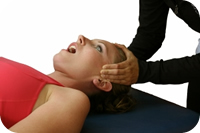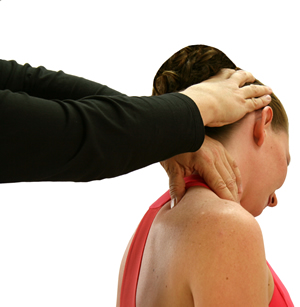Resolving Tension Headaches
 Approximately 90 percent of headaches originate as tension headaches. Medical experts continue to debate over the causes of tension headaches. In my opinion, 90% of tension headaches are either caused by mechanical factors or are perpetuated by them. In other words, most ongoing, chronic, tension headaches can be attributed to specific physical restrictions. These are restrictions in muscles, ligaments, tendons, and fascia which cause nerve impingement syndromes, vascular changes, motion compensations and the output of biochemical substances that affect pain centres.
Approximately 90 percent of headaches originate as tension headaches. Medical experts continue to debate over the causes of tension headaches. In my opinion, 90% of tension headaches are either caused by mechanical factors or are perpetuated by them. In other words, most ongoing, chronic, tension headaches can be attributed to specific physical restrictions. These are restrictions in muscles, ligaments, tendons, and fascia which cause nerve impingement syndromes, vascular changes, motion compensations and the output of biochemical substances that affect pain centres.
Symptoms of Tension Headaches
Tension headaches usually last from half-an-hour to an hour but they can continue to return for weeks, and in chronic cases, last for years. People who suffer from tension headaches often describe their headache as a dull ache, or they may experience them as a band of tightness around the sides of their head. This band may even feel like a vice compressing their skull. In severe cases the pain may even feel like a hooded cape that drapes over and across the shoulders. Obviously in such severe cases more than just the head is involved in creating the pain syndrome.
The following is a list of some of the common symptoms of tension headaches:
- Band like pressure around the head.
- Difficulty concentrating.
- Difficulty sleeping (insomnia).
- Fatigue and irritability.
- Loss of appetite.
- Neck, jaw/TMJ, or shoulder discomfort.
- Severe pain behind the eyes.
- Tenderness of the scalp.
You can usually differentiate a tension headache from other types of headaches because there are many symptoms you will not experience. For example, tension headaches do not cause visual disturbances, nausea, vomiting, numbness on one side the body, or slurred speech.
Triggers for Tension headaches
Tension headaches are triggered by numerous causes. Some of the potential triggers include:
- Anxiety (including several medications used for reducing anxiety).
- Arthritis
- Clenching or grinding teeth (bruxism).
- Dental Work.
- Depression (including medications used for depression).
- Holding one position for a long time, or working in awkward positions.
- Inflammation of the neck or shoulders.
- Lack of sleep or insomnia.
- Lack of physical activity.
- Overuse of headache medication (3rd most common cause of headaches).
- Poor posture.
- Stress.
- Trauma.
- Whiplash injuries (hyper-extension hyper-flexion injury)
 Nerve Compression
Nerve Compression
Nerve compression can be a major factor in the initiation and perpetuation of tension headaches. If we look at the pathway of different peripheral nerves that transect, or pass under, musculoskeletal structures (muscles, ligaments, tendons, and fascia) it is easy to see how nerve compression can create a tension headache. Consider how a restriction of the following muscles can cause nerve compression which in turn can cause a tension headache.
Muscles:
- Superior obliques
- The Suboccipital nerve supplies input to the muscles of the suboccipital triangle. Compression of this nerve can occur at a muscle called the superior oblique.
- A trigger point in the superior oblique muscle itself will also refer pain to various regions of the head.
- Semispinalis (capitis, cervicis) muscle
- The greater occipital nerve is located directly under the semispinalis capitis muscle. Compression of this nerve is one of the causes of cervicogenic headaches. The symptoms from these headaches are called occipital neuralgias.
- Occipital neuralgia is a medical condition characterized by chronic pain in the upper neck, back of the head and behind the eyes. This is sometimes known as C2 neuralgia or Arnold’s neuralgia.
- SCM (Sternocleidomastoid) muscle
- The lesser occipital nerve and the greater auricular nerve both pass by theSCM. Compression of these nerves will give symptoms of occipital neuralgia.
- Trapezius (upper fibers) muscle
- The third occipital nerve travels under the trapezius muscle until it pierces this muscle and ends up in the lower part of the head (occiput). Compression of this nerve by a restriction in the trapezius muscle can also cause occipital neuralgias.
Biochemical Changes
 If we review the literature on tension headaches there is no doubt that tension headaches are associated with changes in the levels of certain brain chemicals such as serotonin, bradykinins, and substance P.
If we review the literature on tension headaches there is no doubt that tension headaches are associated with changes in the levels of certain brain chemicals such as serotonin, bradykinins, and substance P.
Serotonin acts as a chemical messenger that transmits nerve signals between nerve cells. It also causes blood vessels to narrow.
Bradykinins mediates the inflammatory response, increases vasodilatation(expansion of arteries and veins), and causes contraction of smooth muscle.
Substance P functions as a neurotransmitter, especially in the transmission of pain impulses from peripheral receptors to the central nervous system.
The question is, are these chemical the initial factor that created the headache or are they a secondary consequence of physical restrictions. In my opinion, the physical changes probably took place first; which in turn caused a cascade of events that eventually increased, or altered, the levels of these chemicals.
Support for my perspective comes from what is called central sensitization. Central sensitizationhas been hypothesized as one of the primary mechanisms of chronic pain conditions. Central sensitization occurs when pain receptors in your nervous system (nociceptive neurons) become sensitized by tissue damage or inflammation.
By damage, I am not just referring to some type of trauma like a motor vehicle accident. I am also referring to damage caused by:
- The micro trauma of repetitive strain injuries.
- Stress caused by muscle imbalances.
- Long-term stress placed on your body by poor posture.
- De-conditioned muscles.
- A thickening of the fascia. It is postulated that this thickening is caused by an increase in hyaluronic acid, which causes ‘densification’ of the fascia.
All these causes can produce areas of hyper-tonicity (increased tension) in our bodies that become chronically restricted; such as that huge knot most people have in their shoulders or the one just under the base of their skull.
When these hypertonic tissues becomes irritated or inflamed it releases chemical mediators (bradykinin, serotonin, substance P), which cause a sensitization of nerve endings resulting in pain, tension, and the production of headaches. If we review the history of most patients who suffer from tension headache we will routinely find a source of initial tissue damage (accident, trauma, history of tension) and associated inflammation which causes biochemical changes that elicit headaches.
Treatment of Tension Headaches
 To resolve Tension Headaches it is essential that we remove all physical restrictions throughout the body’s Kinetic Chain. This would include restrictions in your shoulders, neck, jaw, skull, and perhaps other affected areas. In other words, wherever we find restrictions that may be initiating a physical cascade of events that will eventually cause physical or biochemical changes resulting in a headache. This will include:
To resolve Tension Headaches it is essential that we remove all physical restrictions throughout the body’s Kinetic Chain. This would include restrictions in your shoulders, neck, jaw, skull, and perhaps other affected areas. In other words, wherever we find restrictions that may be initiating a physical cascade of events that will eventually cause physical or biochemical changes resulting in a headache. This will include:
- Soft tissue adhesions – These will be found in muscles, ligaments, tendons and fascia. Anywhere that a change in tissue texture, tension, movement or function is noted.
- Peripheral nerve entrapments – Besides the actual tension headache, nerve entrapment symptoms include: paresthesisas or abnormal neurological sensations which include:numbness, tingling, burning, prickling, hyperesthesia (increased sensitivity) and muscle atrophy.
It is extremely important to recognize that if we are only dealing with the headache on a pharmaceutical basis we have not addressed the chronic chain of events that perpetuates the headache.
There is a considerable amount of research in the literature to support this perspective. Even a change in posture can greatly affect the prevalence of a tension headache.
Research has demonstrated that tension or weakness in any of the following areas will cause an increase in both the intensity and frequency of tension headaches.
Examples of Anterior Structures:
- Neck flexor muscles
- Sternocleidomastoid muscle
- Temporalis muscle (above Jaw)
- Examples of Posterior Structures:
- Suboccipital muscles
- Splenius Capitus
- Semispinalis Capitus
- Trapezius
Our clinical experience has shown that the majority of chronic tension headaches can be completely resolved or substantially reduced by using soft tissue therapy (Active Release Techniques, Graston Techniuqe, Fascial Manipulation, or Massage therapy) in conjunction with the correct exercise program.
This information is derived from our Release Your Kinetic Chain Exercise Series. If you would like to more information or to purchase our books please go to www.releaseyourbody.com .
If you would like information about our clinic in Calgary Alberta please go to www.kinetichealth.ca.
Referred pain from the trochlear region in tension-type headache: a myofascial trigger point from the superior oblique muscle. Headache 2005 Jun;45(6):731-7. Fernandez de las Peñas C, Cuadrado ML, Gerwin RD,Pareja JA.
Myofascial trigger points and sensitization: an updated pain model for tension-type headache Fernandez-de-las-Penas C, Cuadrado ML, Arendt-Nielsen L, Simons DG, Pareja JA. Cephalalgia. 2007 May;27(5):383-93. Epub 2007 Mar 14. inDepartment of Physical Therapy, Occupational Therapy, Physical Medicine and Rehabilitation, Universidad Rey Juan Carlos, Madrid, Spain.
Stress-induced pain and muscle activity in patients with migraine and tension-type headache. Leistad RB, Sand T, Westgaard RH, Nilsen KB, Stovner LJ. Cephalalgia. 2006 Jan;26(1):64-73. Department of Neuroscience, Norwegian University of Technology and Science and Department of Neurology and Clinical Neurophysiology, St Olavs Hospital, Trondheim, Norway.
(COPYRIGHT KINETIC HEALTH 2012 – ALL RIGHTS RESERVED)

Leave a Reply